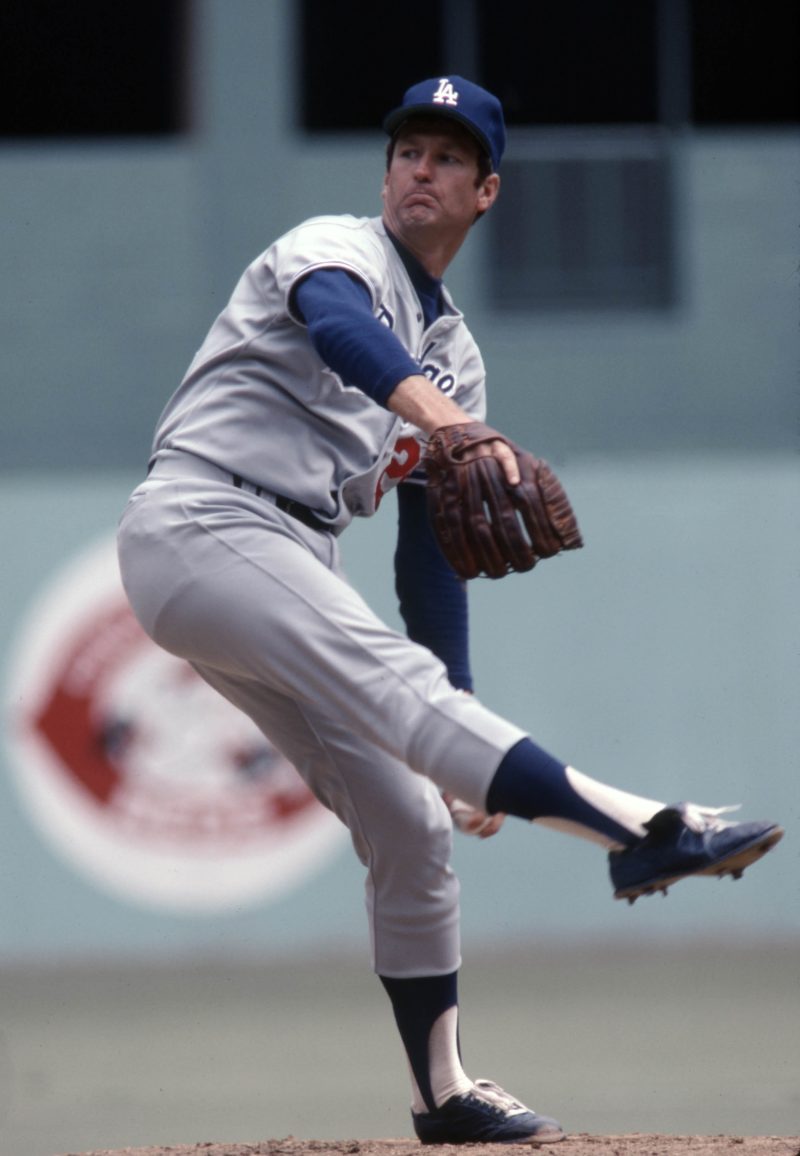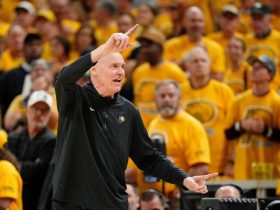OAKLAND — Tommy John, tired of the constant elbow discomfort and cortisone shots, no longer able to throw a pitch without searing pain, pleaded with the Los Angeles Dodgers’ team doctor to try anything humanly possible to keep his baseball career alive.
Dr. Frank Jobe, who worked with children with polio, using tendon transfers to help them, informed John that he could experiment and see if it could work on his elbow. It would be only a 100-1 shot that it would permit him to continue pitching.
John didn’t hesitate and told him to try whatever he needed. Jobe led him into the operating room, removed a tendon from John’s wrist, drilled four holes in the ulna and humerus bones of his left elbow, and grafted the tendons together, holding them in place with anchors.
The date was Sept. 25, 1974.
Fifty years later, it is one of the most innovative and influential surgeries in the history of sports medicine.
Follow every MLB game: Latest MLB scores, stats, schedules and standings.
It is now referred to simply as “Tommy John surgery.’
“It’s amazing how many careers that surgery has saved,’ John, 81, tells USA TODAY Sports from his Florida home. “It was just an experimental surgery. I would have tried many things to come back and pitch. I told Dr. Jobe, do whatever you can to fix it. If it works, it works. If it doesn’t, hey, we gave it our best.
“Thank God it worked. It was such a blessing. The only thing I hate is that 50 years later, it’s needed more than ever, and that’s sad. You would think with modern training and techniques, pitchers wouldn’t need that surgery as much.’
John, the first athlete to undergo surgery replacing his ulnar collateral ligament, went on to pitch for another 14 years while winning 164 more games. It was four years before the surgery was performed again, on San Diego Padres pitcher Brent Strom, now the Arizona Diamondbacks’ pitching coach. He never made it back to the big leagues.
Today, studies reveal that 36% of all active Major League pitchers have undergone Tommy John surgery, and the rate continues to increase every year. There were more in MLB last year than the entire 1990s.
“We’ve created a problem with such a great surgical procedure,’ Dr. James Andrews, who retired in January, tells USA TODAY Sports. “When you have success, you’ve got problems that come with it, and now we have to solve those problems.
“This was developed for professional pitchers, but the injury rate for the ligament injury in youth sports is 10 times greater than it was in 2000. They are hurting their arm ligaments before they even get out of high school and coming in and getting surgery. That’s just terrible. I don’t know any other words to say it, but it’s troubling.’
The sickening aspect, Andrews says, is that parents are eagerly bringing their kids to undergo elbow surgery, believing it will make their ligaments stronger and turn them into major league pitchers.
“These parents are smiling when they bring their kids in and are told they need surgery,’ Andrews says. “Some of them don’t even need surgery, but they’re asking to have an operation. Some of these kids are 12 years old and don’t have a mature growth plate.
“That’s not right. It’s just ridiculous. It’s an amazing operation for a lot of people, but it’s only an 85-to-90% success rate. I tell them that, but they don’t care. It’s just a shame.’
The biggest problem, renowned surgeons like Dr. Neal ElAttrache, Dr. Keith Meister, Dr. Tim Kremchek and Andrews say, is baseball’s love affair with velocity. High school kids are throwing every pitch as hard as they can to get noticed by the pros and collegiate baseball programs. Professional pitchers are throwing as hard as they can to get paid as much as possible.
And if they break down, they’ll just undergo surgery and take a year off. If they to go under the knife again a few years later, so be it.
“These guys come up, and are gassing it as hard as they can at max effort,’ says Kremchek, the Cincinnati Reds’ medical director and chief orthopedic surgeon for 26 years, who has performed more than 3,000 surgeries. “The body can only take so much. These guys keep having surgeries, but eventually you run out of trinkets to fix them.
“The love affair with velocity has changed the game, no question. The days of learning to pitch is over. It’s spin rate, and how hard you can throw. It’s ruined the game.’
According to Meister, a Perfect Game showcase in 2012 had three pitchers who threw 94 mph or higher. It increased to 17 kids a year later.
And in 2023, it spiked to 54 kids who were at 95 mph or higher.
“There’s such a huge focus on velocity and spin rate,’ Meister says, “that it completely changed the landscape and the challenges we have to face. When you have all of these high velocities and spin rate, the ligament is not going to last. It’s not sustainable. It’s not sustainable at all.
“The pendulum needs to change back. Things aren’t changing for the better, things are changing for the worse. It’s just so frustrating. I’ve come up with a couple of things baseball can do to help mitigate it, but it’s kind of fallen on deaf ears.’
Meister, who’s on MLB’s committee to examine the epidemic, suggested that since baseball can’t limit pitchers’ velocity, how about making rule changes to reduce the stress? He recommended a rule change that if a player fouls off a pitch with two strikes, he’s automatically out. It was quickly dismissed since MLB is trying to increase offense, not stifle it. He suggested changing a walk from four balls to three, drastically reducing the amount of pitches thrown in a season.
“Why can’t we do something dramatic?’ says Meister, who performed 240 Tommy John surgeries last year and projects to do 300 this year. “The other leagues make changes and adapt. You have the three-point line now in basketball. You have the two-point conversion in football. Why can’t baseball do something like that?
“Look, nothing’s going to change at the lowest levels if you don’t change at the high levels. Something needs to be done.’
ElAttrache completely agrees, believing that MLB needs rule changes to protect pitchers, enabling them to pitch deeper in games. When John returned and won 20 games for the first time in 1977, finishing second in the Cy Young race, there were 907 complete games, 11 by John.
This season, there have been 27 complete games and no pitcher has more than two.
“The thing I’ve talked to the commissioner’s office about is decreasing the amount of exposure,’ ElAttrache says. “If you look at the number of stressful innings and stressful pitches these guys are throwing, I think possibly putting in a seven- or eight-pitch maximum to hitters. So, either you’ve walked, struck out or got a hit by the eighth pitch. If not, you’re automatically out.’
Three-time Cy Young award winner Max Scherzer of the Texas Rangers believes that MLB should rescind the complete ban of using sticky foreign substances. He insists the rule change is responsible for the increase in UCL surgeries, saying it causes pitchers to grip the ball harder to increase their spin rate and velocity.
The surgeons agree.
“Now that the tacky substances are eliminated, you’ve got guys that grip the ball with a death grip on every pitch to get the kind of spin they need,’ ElAttrache says. ‘They have to grip the ball in a way that’s very, very hard on the flexor pronator tendons of the elbow.
“Then, at the same time, you put in a pitch clock, so you’ve eliminated the ability to recover in between pitches. You get a guy that is fatigued, and research shows the greatest thing that correlates with injury is fatigue.’
Says Meister: “They’re forcing pitchers to squeeze the baseball that much more, and it puts more pressure on the elbow. I don’t know why they can’t have pitchers using pine tar; hitters use it. Put it on the mound. I’m not saying your hand can be gooped with all of that crap, but there’s got to be a reasonable compromise here if they really want to help prevent these injuries.’
MLB better find some answers quickly, the doctors say, or they’ll soon be running out of pitchers.
“I’d love to ban radar guns at the high school level,’ Kremchek says, “to force pitchers to learn the art of pitching instead of seeing how hard they can throw it. When you look back, that’s why the surgery on Tommy John was successful. John threw in the mid-80s. If he was throwing 95 mph or more, he probably would have just blown out, and we never would have heard of Tommy John surgery.’
John, who’s scheduled to undergo surgery in October for bladder cancer, wonders, too, what would have happened if the surgery wasn’t successful. There were some complications. It wasn’t as if he returned in 12 to 14 months like today’s pitchers and was lighting up the radar gun like nothing happened. He was 13-3 with a 2.59 ERA when he underwent surgery, and it took him 2 ½ years before he was dominant once again.
“If it didn’t work the first time, knowing Dr. Jobe like I did, he would have tried it again,’ ElAttrache says. “Frank was convinced that this was the main thing that was causing these problems in pitchers’ elbows, and was convinced that he had a good way of treating it. He took care of children with polio, and those tendon transfers were a very, very important part of what he did. He saw how tendons could be transplanted and used in different ways, so he was convinced that was a good way to reconstruct that ligament.’
Jobe, who died in 2014 and recognized as one of the most gifted surgeons who graced an operating room, was so confident in his abilities that when he was honored by the Baseball Hall of Fame in 2013, he apologized at dinner to Hall of Famer Sandy Koufax. Koufax, who went 27-9 with a 1.73 ERA in 1966, leading the league with 27 complete games and 323 innings, abruptly retired after 12 seasons because of the constant elbow pain.
He was 30 years old.
“Frank apologized to Sandy, in front of all of us, for not having conceived that operation a few years earlier,’ ElAttrache says, “because he said it would have saved Sandy’s career.’
But he was on right on time to save John’s career, and after 288 victories, there’s one common question John is always asked about the surgery.
Why was it named after him and not Dr. Jobe himself?
“I asked Frank about that,’ John says. “He was such a humble guy, but he told me that he was tired of saying ‘ulnar collateral ligament replacement surgery with the palmaris longus tendon.’ It was easier for him to say, ‘Oh, the surgery I performed on Tommy John.’
“It quickly just became, ‘Tommy John surgery.”
Now, 50 years later, it has become a fabric of the game, with pitchers coming in for second and even third surgeries – with an improved internal brace procedure that can shorten the recovery time to about one year instead of 14-18 months.
“They’ve made great strides with the internal brace,’ Andrews says from his Birmingham, Alabama, home, “and pretty soon they’ll all have the internal brace. But there have been so many re-dos. They have surgery, throw 100 mph again, come back and have a re-do. They’re not afraid to blow their elbows out. What they don’t realize is that the re-do surgery has only about 40% success rate.’
Andrews pauses momentarily, and says, “We’ve spent all of this time putting Humpty Dumpty back together again, but we’re remiss in not focusing enough on prevention. Let’s not worry about how many operations we’ve done, but how many we can prevent.
“We created this mess.
“It’s time to fix it.’
Follow Nightengale on X: @Bnightengale
The USA TODAY app gets you to the heart of the news — fast. Download for award-winning coverage, crosswords, audio storytelling, the eNewspaper and more.






